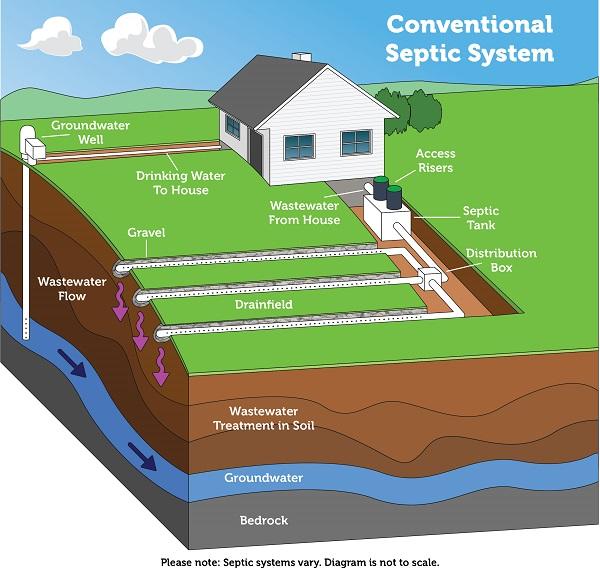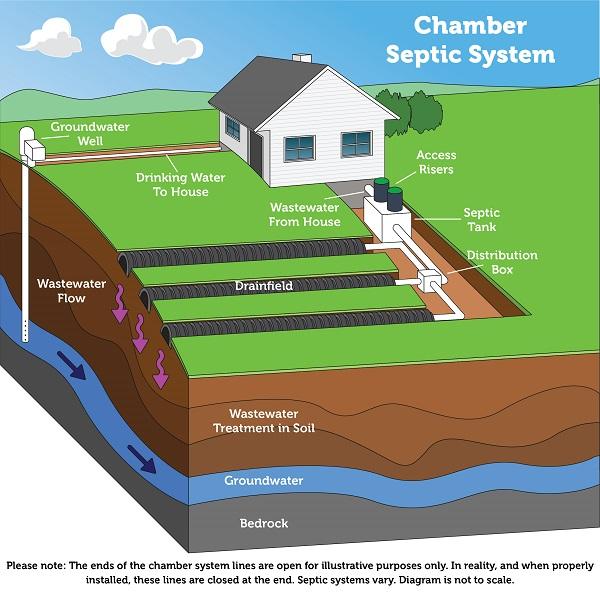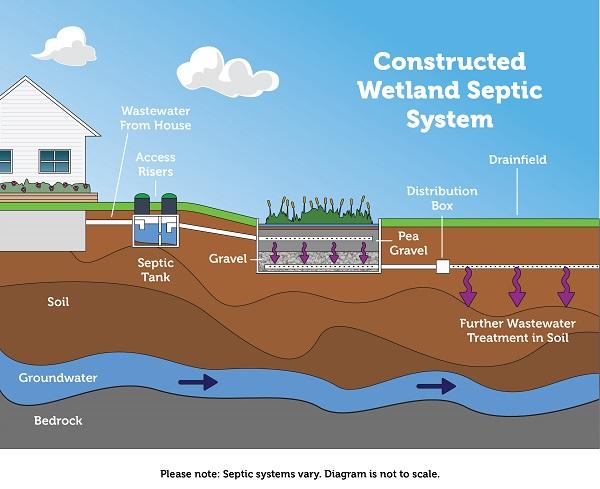
How Conventional Septic Systems Work
Typically installed at a single-family dwelling, a conventional septic system also works well for small businesses. Because of the large overall footprint needed for underground trenches, such a system may not be suitable for all sites or environmental conditions.
The long-term viability of such systems depends on using the services of companies that pump out septic tanks such as Integrity Septic & Drain, serving septic system owners in Benton TN, Sale Creek TN, Cleveland TN, South Pittsburgh TN, Soddy Daisy TN, and surrounding communities.
The goal of the system is to use the soil to filter and treat wastewater for the safe disbursement of effluent without contaminating groundwater far below it, which may provide drinkable water from a private well for the inhabitants. The well and septic system function independently from one another.
Decentralized in design, this type of wastewater treatment system usually consists of a septic tank connecting through pipes to an underground trench, or “septic drain field,” through which the effluent is distributed.
For decades, drain fields consisting of gravel and stone buried at shallow depths have effectively worked to filter the effluent to remove impurities from the liquid that emerges in the septic tank so it safely absorbs into the soil. Usually topped by a geofabric material, such trenches work to keep contaminants like sand and dirt from entering the clean stone. Further treatment by microbes happens once the effluent filters down to the soil beneath the trench to keep the groundwater drinkable.
Key to the longevity of septic systems is removing sludge build-up in the tank and lines by pumping it out every 3-5 years. Looking for companies that pump out septic tanks near Benton TN, Sale Creek TN, Cleveland TN, South Pittsburgh TN, Soddy Daisy TN, or surrounding communities? Integrity Septic & Drain provides 24-hour emergency service. Call (423) 529-9855 to learn more.

Chamber Systems
Gravel-less drain fields have been widely used for over 30 years in many states and have become a conventional technology replacing gravel systems. These systems take many forms, including open-bottom chambers, fabric-wrapped pipe, and synthetic materials such as expanded polystyrene media. This septic system can be manufactured with recycled materials and offer a significant savings in carbon footprint.
An example of a gravel-less system is the chamber system. The chamber system serves as an alternative design to the gravel/stone system and is used in many homes across the country. The primary advantage of the chamber system is increased ease of delivery and construction. This system is also well suited to areas with high groundwater tables, where the volume of influent to the septic system is variable, in an area where gravel is scarce, or in areas where other technologies such as plastic chambers are readily available.
This type of system consists of a series of connected chambers, with the area around and above the chamber filled with soil. Pipes carry wastewater from the septic tank to the chambers and, once In the chambers, the wastewater comes into contact with the soil. Microbes on or near the soil treat the effluent, breaking down the waste.

Drip Distribution System
The drip distribution system is a type of effluent dispersal that can be used in a multitude of drain fields. The main advantage of this system is that no large mound of soil is needed as the drip laterals are inserted into the top 6 to 12 inches of soil. The disadvantage of the drip distribution system is that it requires a large dose tank after the main septic tank to accommodate the timed dose delivery of wastewater to the drip absorption area. Additional components, such as electrical power, are necessary for this system, requiring increased maintenance and an added expense.

Aerobic Treatment Unit
Aerobic Treatment Units (ATUs) use many of the same processes as a municipal sewage plant, but on a much smaller scale. An ATU system injects oxygen into the treatment tank, increasing natural bacterial activity within the system that then provides additional treatment for nutrients in the effluent. Some ATU systems may also have a pretreatment tank and a final treatment tank including disinfection to further reduce pathogen levels.
The benefits of the ATU system are that it can be used in homes with smaller lots, in areas where the water table is too high, in areas with inadequate soil conditions, or for homes close to a surface water body sensitive to contamination by nutrients contained in wastewater effluent. Regular lifetime maintenance should be expected for ATU systems.

Mound Systems
Mound systems are an option in areas of that have shallow soil depth, high groundwater, or shallow bedrock. The constructed sand mound contains a drainfield trench and effluent from the septic tank flows to a pump chamber where it is then pumped to the mound in prescribed doses. Treatment of the effluent occurs as it discharges to the trench and filters through the sand, dispersing into the native soil.
While mound systems can be a good solution for certain soil conditions, they require periodic maintenance and a substantial amount of space to be effective.

Recirculating Sand Filter System
Sand filter systems can be constructed above or below ground. Effluent flows from the septic tank to a pump chamber and is then pumped to the sand filter. The sand filter is often PVC-lined or a concrete box filled with a sand material. Effluent is pumped under low pressure through the pipes at the top of the filter. The effluent then leaves the pipes and is treated as it filters through the sand. The treated wastewater is then discharged to the drainfield.
Sand filters provide a high level of treatment for nutrients and are good for sites with high water tables or areas that are close to water bodies. However, they are more expensive than a conventional septic system.

Evapotranspiration System
Evapotranspiration systems have unique drain fields. The base of the evapotranspiration system drain field is lined with a watertight material and, after the effluent enters the drain field, it evaporates into the air. Unlike other septic system designs, the effluent never filters to the soil and never reaches groundwater.
Evapotranspiration systems are only useful in specific environmental conditions where the climate is arid and has adequate heat and sunlight. These systems work well in shallow soil; however, they are at risk of failure if it rains or snows too much in the area in which they are located.

Constructed Wetland System
A constructed wetland mimics the treatment processes that occur in naturally occurring wetlands. Wastewater flows from the septic tank and enters the wetland cell. The wastewater then passes through the media and is treated by microbes, plants, and other media that remove pathogens and nutrients. The wetland cell typically consists of an impermeable liner, and gravel and sand fill, along with the appropriate wetland plants, which must be able to survive in a perpetually saturated environment.
A wetland system can work via either gravity flow or pressure distribution. As wastewater flows through the wetland, it may exit the wetland and flow into a drain field for further wastewater treatment into the soil.

Cluster / Community System
A decentralized wastewater treatment system, under some form of common ownership, that collects wastewater from two or more dwellings or buildings and conveys it to a treatment and dispersal system located on a suitable site near the dwellings or buildings. It is common to find cluster systems in places like rural subdivisions where the benefits of the system outweigh any of the issues associated with cost and maintenance.

